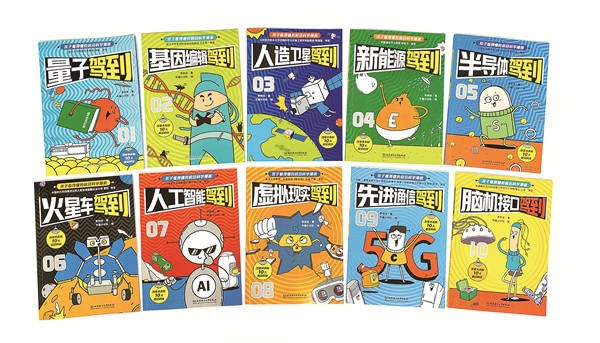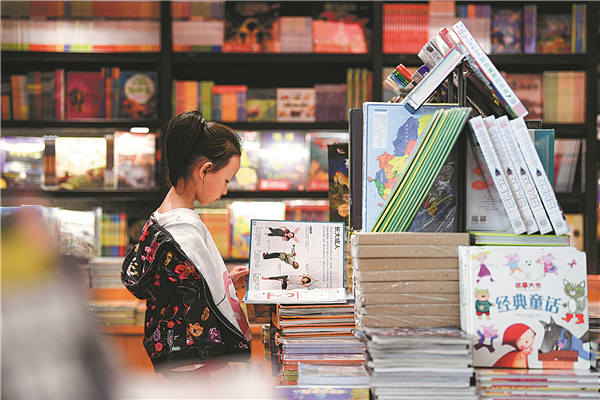
Hi, Tech-Frontier Science Comics for Children, a set of 10 booklets, introduces cutting-edge science topics in 10 fields, ranging from quantum physics and virtual reality to artificial intelligence. [Photo provided to China Daily]
Fun approach to get young readers interested in subject is proving to be a successful formula, Xu Lin reports.
Wang Qiran, 6, is interested in some profound topics, which, to put it mildly, are not usual for someone of his tender years. These topics include gene editing and brain-computer interface.
It's because he's reading Hi, Tech-Frontier Science Comics for Children, a set of 10 booklets that introduce cutting-edge science in 10 fields, ranging from quantum physics and virtual reality to artificial intelligence.
"He loves the comics very much. The drawings use examples in daily life to explain complicated scientific issues. Exposure to science education in childhood is important-it will broaden one's horizon and arouse one's interest in science," says his mother Ying Shanshan, a material engineer and postdoctoral fellow in Hangzhou, Zhejiang province.
She often takes her son to science and technology museums and shows him short videos that popularize science.
Published by Beijing Institute of Technology Press, the collection attracting the boy is a new work by Li Jianlong and illustrating team Niu Mao Xiao Fen Dui.
"I hope that young readers will be interested in science and engineering subjects that they will learn in their later studies," says Li, 36, from Hangzhou, who has a doctorate in theoretical physics.
"When they learn physics and chemistry in junior middle school, they will know that these are foundational subjects for science knowledge that they read in the booklets. They may think that learning science can also be fun."
With more than 1.48 million followers on Sina Weibo, he has dedicated himself to promoting scientific knowledge via comics that are easy to understand.
He's responsible for ideas and content, from selecting a topic, reading related literature, to scriptwriting. He describes his thoughts about specific drawings, including details, to illustrators who then work on them.
He intends to include in the collection some forward-looking technologies, before they are widely applied in people's life, and important technologies that have made breakthroughs, like miniaturized artificial satellites for commercial purposes.

The booklets use cartoons to interpret scientific facts with simple yet appropriate metaphors. [Photo provided to China Daily]
Each booklet has been proofread by an expert in the specific field, to ensure accuracy. Li also lists several questions and answers at the end of each booklet, for those who want to know more about the subject.
"Children can only understand things related to their life, and abstract academic definitions are all Greek to them. You have to put yourself in their shoes," he says.
"That's also a difficulty for me to deal with. I have to 'translate' the scientific materials that I read into simple yet appropriate metaphors."
He says it's essential to draw the attention of children with an interesting story first, so that they will think the technology is great fun. Then, he starts to explain the basic theories, review its development and predict its application in the future, with other stories.
One of the booklets offers a vivid narration of a cute cartoon image of China's Mars rover, introducing its major detection tasks, such as a survey of the topography and geology of Mars and its weather and magnetic characteristics.
China's Tianwen 1 mission, consisting of an orbiter, a lander and a rover, was launched on July 23,2020. It so happened that Li was selecting topics for the booklets around that time, so he decided to include China's Mars rover in the collection, to keep up with current events.
In May, China successfully landed its first Mars rover Zhurong, named after the god of fire in ancient Chinese mythology, on the red planet.
On Aug 15, Zhurong had been on the surface of Mars for 90 Martian days, or about 92 Earth days, accomplishing its exploration and detection tasks as planned.
When they were creating the comics about what China's Mars rover does, Zhurong was actually on its way to the red planet. It's such a coincidence that the collection's publishing date is at a similar time with the estimated landing date of Zhurong.

A girl is captivated by books in Sisyphe Bookstore in the Ningxia Hui autonomous region in May. Many residents choose to read and select books to buy there in their spare time. FENG KAIHUA/XINHUA
"Landing of a Mars rover represents China's comprehensive national strength. Telling the story to children will arouse their interest in space exploration," Li says.
The Ministry of Education announced that all primary schools in China should offer science courses for students from grade one, instead of the previous requirement of grade three, starting from September 2017.
It means science has become an equally important fundamental course at primary schools, just like Chinese and mathematics.
Li and his team have published several other comic books in recent years that popularize scientific knowledge among children, hoping these will be a supplement to the current science education in China.
"It's important to enhance one's science literacy since childhood. One way is to encourage them to read related books," Li says.
He says he notices that current children's books about science mainly introduce knowledge originated in the 19th century like electricity and light. Some books about frontier science are hard to understand, because they use scientific terms.
"Children are curious about everything. I want to impart knowledge about the latest science and technology to them in an easy way," he says.
"I hope that they will realize that the things scientists are doing are both valuable and interesting. It's like planting a seed in their heart, and they may also want to be a scientist when they grow up."

